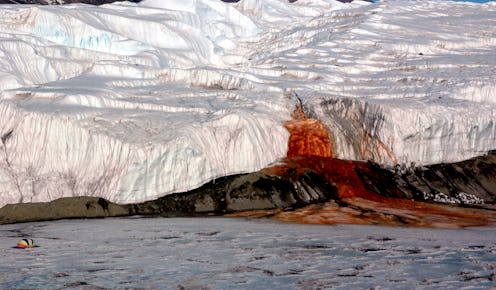Life
This Creepy Natural Phenomenon Has A Totally Normal Explanation
Surrounded by glacial ice, it looks like something out of a horror movie: the gruesome red ooze of Antarctica's Blood Falls. The striking natural phenomenon was discovered in 1911 by geoscientist Griffith Taylor. Now, over a hundred years later, the mystery of why Blood Falls is red has finally been solved. Located in the McMurdo Dry Valleys, rust-colored liquid runs out of fissures in the Taylor Glacier, giving the falls their foreboding name. Scientists have long guessed at the source of the falls, and what seemingly unnatural alchemy could lead to such a unique color. One popular long-held belief was that the presence of red algae frozen in the snow and ice gave the falls their gory tint, but a new study published in in The Journal of Glaciology has not only identified what makes the falls red, but also the key to their very existence.
Researchers out of the University of Alaska Fairbanks and Colorado College used radio echo sounding, also known as ice-penetrating radar, to map what lay beneath the surface of Taylor Glacier. By moving antennae in grid-like patterns, the research team was able to identify the source of the flow, revealing "a complex network of subglacial rivers and a subglacial lake — all filled with brine high in iron, giving the falls its reddish tint," explains National Geographic. When the salty, iron-rich water bleeds out of the openings in the glacier and first comes in contact with the air, the bright red color is produced. When the falls aren't flowing, they turn a dried rust color, like a scab covering a wound. It seems these falls can make you shiver from more than just the cold.
With annual freezing cold temperatures of −17°C and limited observable surface melt, scientists had assumed the conditions of Taylor Glacier were too cold for any running water to be possible. As such, the mystery of the sporadic flow of the falls was long debated. So how does iron-filled water buried in a million-year-old lake carve its way 300 feet through glacial ice to exit the falls? The team of researchers found that it was the unique makeup of the water, high in saline, that helped it stay in its liquid form and forge on through the freshwater ice. "While it sounds counterintuitive, water releases heat as it freezes, and that heat warms the surrounding colder ice," notes the press release.
The lower freezing temperature of salty water combined with the heat it produces as it freezes forged the rivers that lead to the falls, and made it easier for the scientists to spot. "The salts in the brine made this discovery possible by amplifying contrast with the fresh glacier ice," explains Jessica Badgeley, the study's lead author and an undergraduate at Colorado College. Taylor Glacier is now the coldest known glacier to have water flowing through it continuously, a feat once thought impossible by scientists.
The mystery may have turned out to be less creepy than it at first appeared — but there's still something to be said for something that literally looks like a waterfall of blood. The Shining's bloody elevator doesn't look so bad in comparison, does it?
